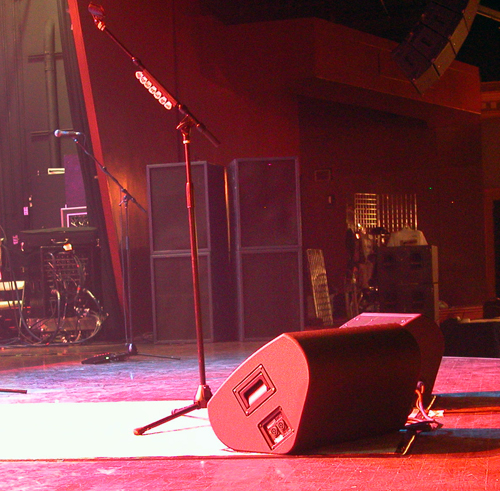
Multiple Duties
Some bands have dedicated backing vocalists. Sure, they may wave a tambourine or hit a cowbell now and then (and who doesn’t want more cowbell?), but primarily their function is to sing.
More often than not, they’re positioned in a row, and frequently on a riser. Because risers aren’t as solidly built as stages, they’re very susceptible to transmitting noise into mics (especially if the singers like to dance), so it’s wise to use large cast base stands with rubber feet.
Also if possible, provide vocalists with their own monitor wedges, even if they’re all getting the same mix. That way each wedge can be positioned directly behind the null zone of its respective mic. Placing wedges between the mics opens up potential bleed problems.
I make sure that all of the vocalists can be heard in each other’s monitors at the outset of sound check, as well as some kick drum, keyboards and a little rhythm guitar. This provides a solid starting point.
BGVs can have one or more jobs over the course of a show – singing harmony with the lead, singing as a chorus in unison with or without the lead, solos, and duets with the lead or each other. As noted, my own preference is to have all BGVs on the same mic model unless one of the singers has a vastly different style or range (like a dedicated bass singer who “eats” the mic).
In sound check, I start by tailoring the EQ for each singer, usually rolling off the bottom end around 80 to 100 Hz for males unless they sing bass, where it’s lowered to the 60 to 80 Hz range. For females, the roll off is usually at 100 to 140 Hz. The goal is keeping stage rumble and wayward bass frequencies out of the mix.
I may also “thin out” male vocals a bit in the 160 to 400 Hz range when they’re supporting a male lead vocal to give them a distinct place in the mix. The same goes in the 200 to 500 Hz range with female BGVs supporting a female lead vocal. Some of the highs may be rolled off as well to help the lead vocal stand out. The idea is to get all vocals fitting right without overshadowing the lead. BGVs usually need to sound like a tight and cohesive unit that’s a complement to the lead, rather than a group of distinct individuals.
Another thing that can help is keeping lead vocal focused a bit more center, with background vocals somewhat more to the sides. A trick I picked up from a recording engineer is to pan backing vocals off to one side and apply a short slap-back echo (no more than 20 to 30 ms or so), with that echo panned over to the other side. This can deliver an overall fuller vocal sound without things being too busy in the center where the lead resides.
Seamless Blend
I’m not a fan of gates on vocals (or gates in general), and also tend to use minimal channel compression, only applying a bit when necessary to keep levels in check. Typically, I route vocals to sub-groups on the console and use one VCA/DCA for control of all BGVs and another VCA/DCA for control of the lead. A bit of compression can be applied to these sub-groups if needed but it’s important not to “squash” anything.
Vocal or room-type reverb can add a bit of life to the lead, but care needs to be taken when adding reverb to background vocals. Rolling off the lows on the reverb return is usually a good idea to keep the overall vocal mix clean while fostering intelligibility of the lead vocal. A longer reverb on BGVs, such as large room or big hall, can further help in this regard.
A few times I’ve worked with bands where some pre-recorded backing vocals are triggered (by a musician in the band or crew member). When this is the case, it’s important to make sure that any click tracks are routed to the correct monitors. Also spend some time listening to the tracks to make sure they all sound similar and that the levels are consistent. If necessary, place a compressor on the tracks to keep levels in check.
Most of these tracks are simply a stereo mix, but if the playback unit offers multi-track outputs, treat each track as a separate vocalist. And apply the same panning approach noted earlier, with the tracks a bit more to the sides. The trick is to seamlessly blend the recorded tracks – sonically and visually – with the live singers on stage.
Senior contributing editor Craig Leerman is the owner of Tech Works, a production company based in Las Vegas.

